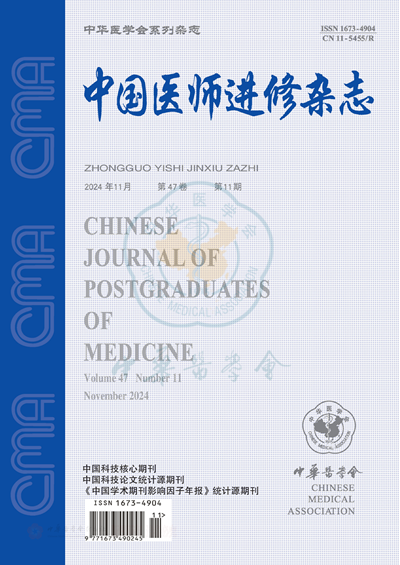Relationship between platelet activating factor acetylhydrolase genetic polymorphism and platelet activation and prognosis in patients with ischemic stroke
引用次数: 0
Abstract
Objective To investigate the corelation between platelet activating factor acetylhydrolase (PAF-AH) genetic polymorphism and ischemic stroke. Methods The plasma PAF-AH genotype was determined in 205 patients with iachemic stroke and 114 normal subjects by the polymerase chain reaction. The levels of plasma platelet activating factor (PAF), platelet α-granule membrane glycoprotein-140(GMP-140), β-thromboglobulin (β-TG) and the levels of platelet factor 4 (PF4) were analyzed. Results The prevalence of the mutation genotype and plasma PAF, GMP-140, β-TG and PF4 in the patients with isehemic stroke [42.44%,(91.08 ± 39.10) ng/L, (36.46 ± 13.10) μg/L, (41.75 ± 11.18) μg/L, (29.05 ± 9.16) g/L, respectively] were significantly higher than those in the controls[21.05%,(64.30 ± 18.81) ng/L, (18.27 ± 7.68) μg/L, (30.94 ± 8.47) μg/L, (18.75 ± 6.06) μg/L](P< 0.01). The levels of plasma PAF, GMP-140 were significantly higher in mutation genotype patients than those in the normal genotype patients (P < 0.01). Conclusions The activation function of platelet in the acute phase of patients with ischemic stroke increases, and it is associated with genetic polymorphism of PAF-AH. The PAF-AH gene mutation may be a novel genetic marker for high risk of ischemic stroke. Key words: Cerebrovascular anident; Platelet activation; 1-Alkyl-2-acetylglycerophospho-choline esterase; Gene polymorphism缺血性脑卒中患者血小板活化因子乙酰水解酶基因多态性与血小板活化及预后的关系
目的探讨血小板活化因子乙酰水解酶(PAF-AH)基因多态性与缺血性脑卒中的相关性。方法采用聚合酶链反应法测定205例缺血性脑卒中患者和114例正常人血浆PAF-AH基因型。分析血浆血小板活化因子(PAF)、血小板α-颗粒膜糖蛋白-140(GMP-140)、β-血小板球蛋白(β-TG)及血小板因子4 (PF4)水平。结果缺血性卒中患者突变基因型及血浆PAF、GMP-140、β-TG、PF4患病率[分别为42.44%、(91.08±39.10)ng/L、(36.46±13.10)g/L、(41.75±11.18)g/L、(29.05±9.16)g/L]显著高于对照组[21.05%、(64.30±18.81)ng/L、(18.27±7.68)g/L、(30.94±8.47)g/L、(18.75±6.06)g/L](P< 0.01)。突变基因型患者血浆PAF、GMP-140水平显著高于正常基因型患者(P < 0.01)。结论缺血性脑卒中患者急性期血小板活化功能增强,与PAF-AH基因多态性有关。PAF-AH基因突变可能是缺血性卒中高危人群的一种新的遗传标记。关键词:脑血管;血小板活化;1-Alkyl-2-acetylglycerophospho-choline酯酶;基因多态性
本文章由计算机程序翻译,如有差异,请以英文原文为准。
求助全文
约1分钟内获得全文
求助全文
来源期刊
自引率
0.00%
发文量
26239
期刊介绍:
Chinese Journal of Postgraduates of Medicine (founded in 1978, monthly) is one of the series of journals of the Chinese Medical Association (CMA) under the supervision of the National Health Commission of the People's Republic of China, sponsored by the Chinese Medical Association (CMA) and Dalian Institute of Theoretical Medicine (DITM). It is a core journal of Chinese science and technology, a statistical source journal of Chinese scientific and technical papers, and a statistical source journal of China Academic Journal Impact Factor Annual Report. The journal adheres to the purpose of using continuing medical education and post training, highlights new theories, new knowledge, new methods and new technologies, and focuses on the combination of theory and practice, and the combination of popularisation and improvement.
Main columns: Special tutorials, expert forums, clinical treatises, clinical experience, reviews and lectures, continuing medical education, teaching and research, advanced training forum, drugs and clinics, overview of progress, introduction of new technologies, imaging and clinics, lessons learnt, discussions and evaluations, case reports, discussions of clinical cases, conference proceedings, and domestic and international academic developments.
The main target readers are clinical medical personnel in internal medicine, surgery, gynaecology, paediatrics and ophthalmology.

 求助内容:
求助内容: 应助结果提醒方式:
应助结果提醒方式:


